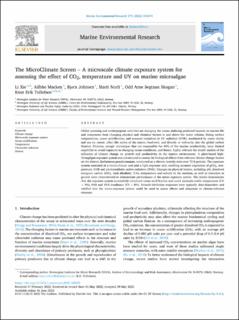| dc.contributor.author | Xie, Li | |
| dc.contributor.author | Macken, Ailbhe | |
| dc.contributor.author | Johnsen, Bjørn | |
| dc.contributor.author | Norli, Marit | |
| dc.contributor.author | Skogan, Odd Arne Segtnan | |
| dc.contributor.author | Tollefsen, Knut-Erik | |
| dc.date.accessioned | 2022-07-13T12:53:13Z | |
| dc.date.available | 2022-07-13T12:53:13Z | |
| dc.date.created | 2022-06-20T13:52:47Z | |
| dc.date.issued | 2022 | |
| dc.identifier.citation | Marine Environmental Research. 2022, 179, 105670. | en_US |
| dc.identifier.issn | 0141-1136 | |
| dc.identifier.uri | https://hdl.handle.net/11250/3005076 | |
| dc.description.abstract | Global warming and anthropogenic activities are changing the ocean, inducing profound impacts on marine life and ecosystems from changing physical and chemical factors in and above the water column. Rising surface temperatures, ocean acidification, and seasonal variations in UV radiation (UVR), modulated by water clarity and sea-ice extent, affect life cycles of the marine food-web, and directly or indirectly also the global carbon fixation. Diatoms, pelagic microalgae that are responsible for 40% of the marine productivity, have limited capability to avoid exposure to changing ocean conditions, and hence, highly relevant for model studies of the influence of climate change on growth and productivity in the marine environment. A plate-based high-throughput exposure system was constructed to assess the biological effects from relevant climate change factors on the diatom Skeletonema pseudocostatum, conducted as a chronic toxicity tests over 72 h periods. The exposure system consisted of a micro-climate unit and a light-exposure unit, enabling accurate regulation of pCO2, temperature, UVR and photosynthetic active radiation (PAR). Changes in physical factors, including pH, dissolved inorganic carbon (DIC), total alkalinity (TA), temperature and salinity in the medium, as well as reduction in growth were characterised to demonstrate performance of the micro exposure system. The results demonstrate that the exposure system successfully simulated ocean acidification and could maintain stable temperature (CV < 3%), PAR and UVR irradiance (CV < 8%). Growth inhibition responses were typically dose-dependent and verified that the micro-exposure system could be used to assess effects and adaptions to climate-relevant stressors. | en_US |
| dc.language.iso | eng | en_US |
| dc.publisher | Elsevier | en_US |
| dc.rights | Navngivelse 4.0 Internasjonal | * |
| dc.rights.uri | http://creativecommons.org/licenses/by/4.0/deed.no | * |
| dc.title | The MicroClimate Screen – A microscale climate exposure system for assessing the effect of CO2, temperature and UV on marine microalgae | en_US |
| dc.type | Peer reviewed | en_US |
| dc.type | Journal article | en_US |
| dc.description.version | publishedVersion | en_US |
| dc.rights.holder | © 2022 The Authors | en_US |
| dc.source.pagenumber | 6 | en_US |
| dc.source.volume | 179 | en_US |
| dc.source.journal | Marine Environmental Research | en_US |
| dc.identifier.doi | 10.1016/j.marenvres.2022.105670 | |
| dc.identifier.cristin | 2033486 | |
| dc.relation.project | Norges forskningsråd: 223268 | en_US |
| dc.relation.project | Norges forskningsråd: 160016 | en_US |
| dc.source.articlenumber | 105670 | en_US |
| cristin.ispublished | true | |
| cristin.fulltext | original | |
| cristin.qualitycode | 2 | |

